Physical Address
304 North Cardinal St.
Dorchester Center, MA 02124
Aortic stenosis is an active, progressive disease that involves inflammatory and bone mineralization pathways.
The stages of aortic stenosis combine hemodynamic assessment, anatomic findings, symptomatic status, and ejection fraction measurements to help categorize management strategies.
Echocardiography is the gold standard for evaluating aortic stenosis.
Stress testing is considered for patients with severe aortic stenosis when the symptom history is equivocal or hemodynamic severity is uncertain due to low-flow states.
No medical therapy has reduced hemodynamic progression, but research is ongoing to identify novel therapeutic targets.
Aortic valve replacement remains standard treatment for severe aortic stenosis when there are symptoms or a reduced ejection fraction.
Transcatheter aortic valve replacement can be performed safely in patients who are at intermediate or high risk of surgical mortality, but definitive long-term durability outcomes beyond 5 years remains lacking.
Aortic stenosis (AS) is common among the elderly. with an estimated prevalence of 12% after 75 years of age. Severe disease occurs in 1% to 3% of those older than 65 years of age, and the rate is expected to increase as the population ages. Despite the rising estimates, temporal trends over 2 decades in the Swedish population have shown lower age-adjusted incidence rates for AS. The decreasing incidence seen over 20 years despite the aging population suggests that better cardiovascular health and modification of risk factors are associated with a lower rate of development of calcific valve disease (see Chapter 4 ).
Although there has been significant advancement in understanding the clinical, genetic, and molecular mechanisms for disease, the treatment for AS remains aortic valve replacement (AVR). The advent of Transcatheter aortic valve replacement (TAVR) provides treatment options for patients who are not candidates or unwilling to undergo surgical aortic valve replacement (SAVR). Continuous improvement in transcatheter techniques and prosthetic valve design, declining SAVR and TAVR morbidity and mortality rates, and better risk stratification are fostering a paradigm shift toward AVR in more patients earlier in the disease course and in those with end-stage disease or multiple comorbidities.
Morbidity from left ventricular (LV) outflow obstruction does not occur until very late in the disease process ( Fig. 9.1 ), and traditional parameters of AS severity often are based on valve hemodynamics. However, AS is an active disease process that is better characterized by the combination of valve leaflet changes, hemodynamics, LV function, and clinical symptoms as defined in the 2014 American College/American Heart Association (ACC/AHA) Guidelines for the Management of Patients with Valvular Heart Disease. Similar to stages of heart failure, AS disease stages are classified using a progressive categorization of patients who are at risk (stage A) to end-stage disease (stage D) ( Table 9.1 ).
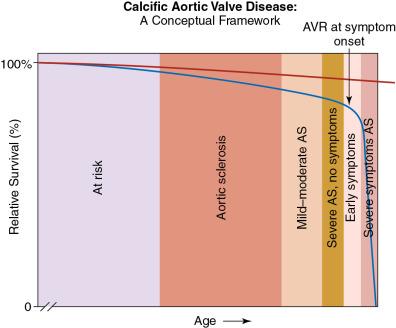
| Stage | Symptom Description | Anatomic Features | Key Hemodynamics | LV Function | Management |
|---|---|---|---|---|---|
|
|
|
|
|
|
|
|
|
|
|
|
|
|
|
|
||
|
|
|
|
||
|
|
|
|
||
|
|
|
|||
|
|
|
|
|
|
|
|
|
|
|
|
|
|
|
|
|
The most common causes of AS are calcific disease, a congenital bicuspid valve, and rheumatic heart disease ( Table 9.2 ). Echocardiography allows an accurate diagnosis with characterization of the number of valve cusps, degree of leaflet calcification, and evidence for commissural fusion in rheumatic valve disease ( Fig. 9.2 ). Calcific disease of a trileaflet valve is rare before the age of 50 years; in older adults, bicuspid valve disease still accounts for most cases of severe AS before the seventh to eighth decade.
| Cause | Clinical Presentation | Associated Findings |
|---|---|---|
| Common | ||
|
|
|
|
|
|
|
|
|
| Uncommon | ||
|
|
|
|
|
|
|
|
|
|
|
|
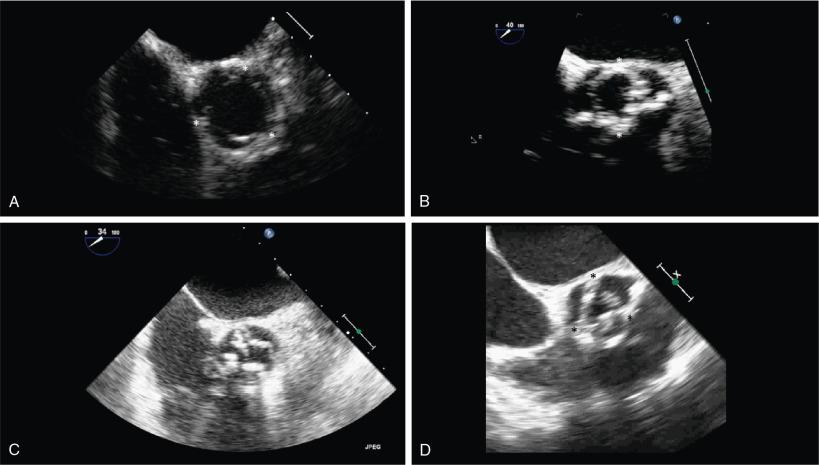
Bicuspid aortic valve disease often is associated with ascending aortic aneurysms and, less commonly, with aortic coarctation (see Chapter 11 ). Rheumatic aortic valve disease is rare in Europe and North America, but it is still prevalent in other world regions and is invariably accompanied by mitral valve involvement.
The most common AS presentation is an asymptomatic systolic murmur during physical examination or an incidental finding on echocardiography. Symptoms due to AS do not appear until significant hemodynamic obstruction occurs, although the exact degree of stenosis resulting in symptoms varies between patients. When outflow obstruction is only mild to moderate, alternative causes of symptoms should be sought.
The classic symptoms of angina, syncope, and heart failure were first described in middle-aged adults with rheumatic heart disease and now are rarely seen in patients who are educated about the disease process and followed prospectively. However, a detailed history is important to identify functional changes over time and to distinguish symptoms of AS from other medical conditions such as coronary disease, pulmonary disease, and deconditioning.
Dyspnea on exertion or decreased exercise tolerance is the most common initial symptom due to AS and is often related to diastolic dysfunction and elevated LV filling pressures. A recent study found that dyspnea was the primary concern in 70% of symptomatic patients and was independently associated with higher Doppler-derived E/e′ ratios. In the elderly, decreased exercise tolerance is not always recognized by the patient as an important symptom because disease progression is insidious, and other comorbidities often contribute to impaired functional status. Approximately 18% to 37% of patients with severe AS initially categorized as asymptomatic have symptoms when performing exercise.
Angina is the second most common symptom of patients with AS. Angina results from a myocardial oxygen supply-demand mismatch and it more often occurs with coexisting coronary artery disease (CAD) and hypertension. Approximately 20% to 50% of patients with AS have coexisting CAD, and the likelihood of coronary disease increases with presence of atherosclerotic risk factors. Myocardial ischemia in AS results from a unique combination of left ventricular hypertrophy (LVH) and associated hemodynamic changes, including a decreased diastolic coronary perfusion pressure, impaired myocardial relaxation, decreased coronary vessel density, shorter diastolic filling times, and microvascular dysfunction. Lower coronary flow reserve also occurs in AS, resulting in exertional angina symptoms.
Syncope or exertional dizziness is the least frequent component of the classic symptom triad. Causes of syncope in AS patients include cardiac arrhythmias, reduced cardiac output due to the narrowed obstructive valve, or a baroreceptor-mediated vasodilatory and bradycardic reflex during high LV wall stress. AS patients with severe stenosis and syncope are reported to have higher LV wall stress and lower stroke volumes. Ectopic ventricular beats are more common when LVH occurs in AS.
The cardiovascular examination for AS focuses on cardiac auscultation and carotid pulse palpation. No single physical examination finding completely excludes AS or predicts severity, but it instead identifies individuals who need further noninvasive testing. The published diagnostic accuracy for physical findings in AS are usually based on highly trained cardiology experts; less experienced examiners may not identify these abnormalities with the same acumen. ,
A systolic ejection murmur is found almost universally in AS. It results from turbulent flow across the narrowed aortic orifice. , The murmur typically is loudest at the base of the heart along the right second intercostal space, but the site of maximum intensity in some people is closer to the apex. Radiation of the murmur to the right clavicular area and carotid artery often is detected; less commonly the murmur radiates toward the apex. The intensity of the murmur does not reliably exclude severe obstruction because most patients with severe AS have only a grade 2 or 3 murmur. However, a very loud murmur (≥grade 4 with a palpable thrill) is very specific for severe AS. Late systolic peaking of the murmur intensity correlates with more severe disease, but the auscultation properties of the murmur in any individual can vary greatly due to individual body habitus, LV function, and coexisting aortic regurgitation.
A soft or single second heart sound (S 2 ) occurs in AS due to the rigidity of the aortic valve cusps, and leaflet closure does not result in an audible sound. The presence of a normally split S in an adult with AS reliability excludes severe valve obstruction.
The carotid arterial pulse is examined for timing and amplitude. A normal carotid pulse is easily palpable with light pressure and occurs simultaneously with precordial apex pulsation. Obstruction to blood flow from AS produces a weak and slowly rising carotid pulse (i.e., pulsus parvus et tardus). However, when there is coexisting hypertension or atherosclerosis, the carotid upstroke is relatively normal in timing and magnitude, reflecting reduced vascular compliance rather than the absence of severe AS.
Echocardiography is the primary diagnostic modality for the evaluation of AS, allowing determination of the cause, disease severity, hemodynamic consequences, and prognosis for clinical decision making. Transthoracic echocardiography is recommended for initial assessment, periodic surveillance, and occurrence of new symptoms or physical examination changes. Blood pressure and heart rate are reported on the echocardiogram at the time of the study because valvular gradients are influenced by hypertension and volume flow rate.
Two-dimensional (2D) transthoracic echocardiography provides imaging of morphology and calcification of the aortic valve (see Fig. 9.2 ). Restricted opening of the aortic valve leaflets is observed, but measuring the anatomic valve area by 2D or 3D echocardiography is limited by irregular 3D surfaces and calcification shadowing artifacts ( Fig. 9.3 ). The severity of calcification is categorized because more severe calcification is associated with more advanced disease ( Fig. 9.4 ). Severity of stenosis is determined from hemodynamic assessment with Doppler echocardiography (see Chapter 8 ). Continuous-wave (CW) Doppler through the aortic valve measures maximum transaortic jet velocity and mean gradient. Severity categories correlate with prognosis ( Fig. 9.5 ), with severe AS defined as maximum velocity above 4 m/s (mean gradient of 40 mmHg), and mild AS is defined as a maximum velocity below 3 m/s (mean gradient of 20 mmHg).
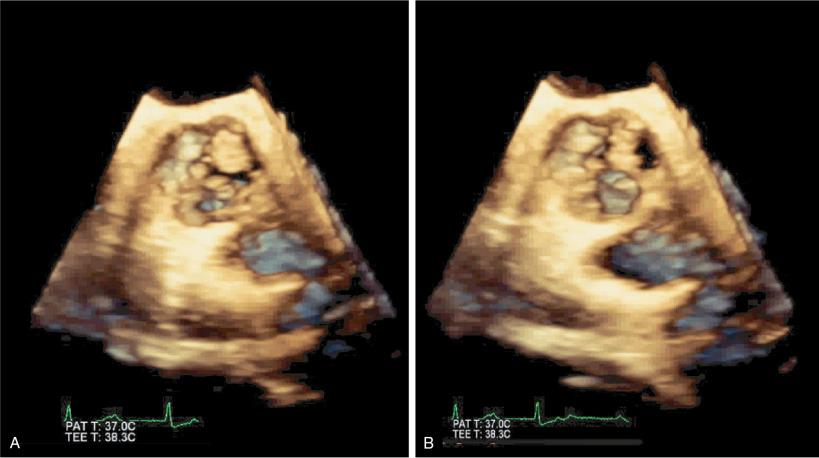
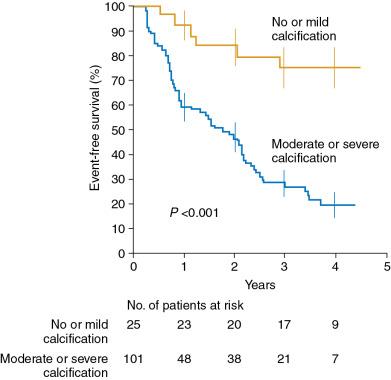
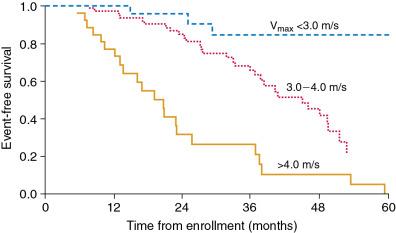
When AS velocity is less than 4 m/s but there is concern about severe AS, the stroke volume index is calculated, and functional aortic valve area (AVA) is calculated using the continuity equation ( Fig. 9.6 ). A low-flow state is defined as a stroke volume index of 35 mL/m 2 or less, and low-flow, low-gradient (LFLG) AS is defined low-flow with a low-gradient (velocity <4.0 m/s) but a valve area of less than 1.0 cm 2 .
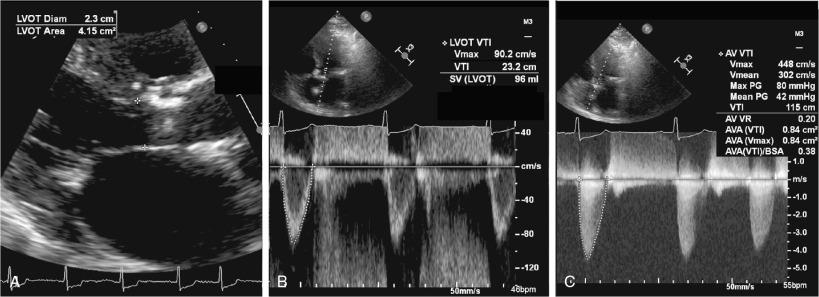
The two main causes of LFLG AS are a reduced LV ejection fraction (EF) (i.e., stage D2 or classic LFLG severe AS) or a small LV chamber size due to concentric LVH with a preserved EF (i.e., stage D3 or paradoxical LFLG severe AS). It also is important to ensure measurement accuracy and avoid an erroneous diagnosis of severe low-flow AS when only moderate AS is present. Potential pitfalls in echocardiographic diagnosis include a nonparallel alignment of the Doppler probe with the aortic jet, incorrect positioning of the sample volume for LV outflow velocities, and underestimation of the LV outflow tract diameter. Oblique image planes result in a smaller measured outflow tract diameter, which is then squared, leading to large errors in the calculated AVA. In adults, LV outflow tract size does not change over time. Changes between studies distinguish between disease progression and measurement variation.
In cases of LFLG severe AS with a low EF (<50%), the next step is low-dose dobutamine stress echocardiography (see Low-Dose Dobutamine Stress Echocardiography ). Diagnosis of paradoxical LFLG AS with discordance between gradients and valve area but a preserved EF often is a diagnostic dilemma. Although diastolic dysfunction, concentric LVH, and reduced LV longitudinal shortening may result in a reduced stroke volume despite a normal EF, meticulous evaluation for possibilities of measurement error should be considered, especially when there is minimal LVH and only mild diastolic changes.
Other possible causes of low flow through the aortic valve, such as mitral regurgitation, atrial fibrillation, significant hypertension, and right heart failure, should be ruled out. In patients with small body sizes, the AVA may be proportionally smaller and can be indexed for body surface area; conversely, AVA does not increase with obesity, and indexing should be used cautiously for patients with a large body size.
When aortic jet velocity is higher than normal (>2 m/s), but the valve does not appear significantly thickened or calcified, other conditions need to be considered. Coexisting aortic regurgitation and other high-flow states produce elevated aortic velocities without obstruction. The level of obstruction must be confirmed because a high outflow velocity may be due to a subaortic membrane or hypertrophic cardiomyopathy. Valvular AS is distinguished from dynamic subvalvular obstruction based on the shape of the CW Doppler velocity curve ( Fig. 9.7 ) and color Doppler evidence for the anatomic site of obstruction. Supravalvular AS is very uncommon and associated with certain congenital conditions such as Williams syndrome and familial hypercholesterolemia. Supravalvular stenosis is identified by high aortic velocity and a very narrow aorta with a normal-appearing valve in susceptible patient populations.
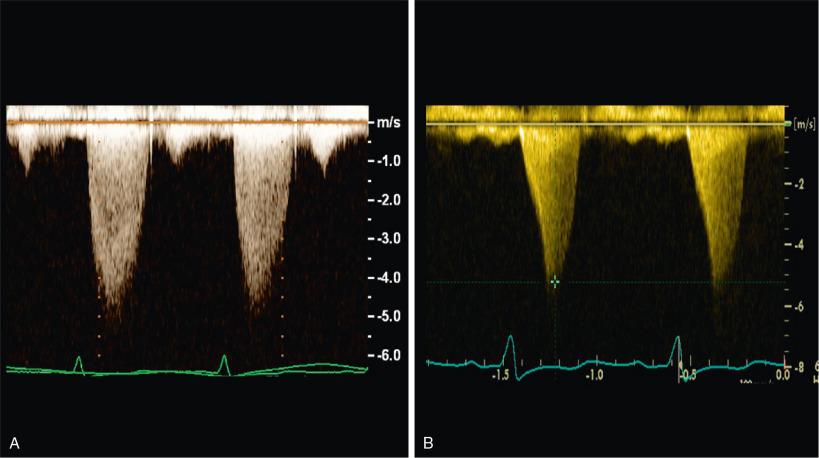
Invasive evaluation for AS is rarely necessary but is helpful in selected cases with discrepant clinical and imaging findings. Care is needed because there is a risk of cerebral emboli with retrograde catheterization across a stenotic aortic valve, although this has not been a major issue in patients undergoing TAVR. Key findings from hemodynamic catheterization include hemodynamic verification of the level of obstruction (i.e., subvalvular or valvular), measurement of the mean systolic pressure gradient, AVA calculation with the Gorlin formula, and the timing and shape of the pressure tracing waveforms. Similar to echocardiography, technical factors with hemodynamic catheterization should be taken into account when interpreting severity.
Pressure tracings are recorded simultaneously in the midcavity of the LV and in the proximal ascending aorta, using 6-Fr or larger catheters with side holes, flushed with saline to optimize the pressure waveform contour in terms of overdumping and underdumping ( Fig. 9.8 ). Less ideal, but a commonly practiced technique, is a single pullback measurement of pressure tracings from the LV to the aorta. The difference between the peak LV and peak aortic pressures (i.e., peak-to-peak gradient) is easy to measure but does not have an echocardiographic correlation because those two pressures do not occur at the same point in time. The maximum instantaneous gradient at catheterization correlates best with the maximum velocity by Doppler echocardiography; mean gradients by both techniques correlate well if loading conditions are matched between the echocardiogram and cardiac catheterization.
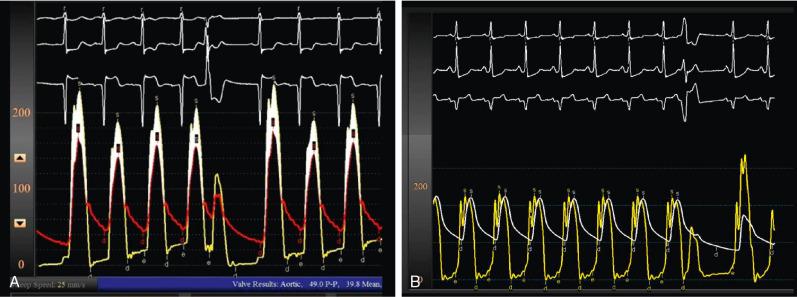
Because AVA calculation depends on measurement of transaortic volume flow rate and pressure measurements, variation in cardiac output techniques affects determination of AVA at cathterization. In clinical practice, cardiac output is measured by thermodilution technique or Fick equation estimates, with potential measurement variations and limitations of each approach. Recognizing the technical pitfalls, echocardiography and catheterization aid in reconciling discrepancies when present.
Stress testing is useful when the decision for AVR remains indeterminate despite the clinical history and resting hemodynamic assessment. The indolent nature of AS often leads patients to consider themselves asymptomatic because they discount symptoms with declining activity. Conversely, symptomatic patients may have low gradients, and the contribution and benefit of correction of the valvular disease may be uncertain. Dynamic assessment with stress testing is performed using exercise or pharmacologic protocols depending on the clinical scenario. Stress testing provides prognostic information by identifying subsets of AS patients who are at high risk for adverse clinical events or AVR ( Table 9.3 ). , , ,
| Study | Mean Follow-Up ( N ) | Protocol | AS Criteria | Abnormal Criteria | Outcome | Key Findings |
|---|---|---|---|---|---|---|
|
|
|
|
|
|
|
|
|
|
|
|
|
|
|
|
|
|
|
|
|
|
|
|
|
|
|
|
|
|
|
|
|
|
|
|
|
|
|
|
|
|
|
|
|
|
|
|
|
|
|
|
|
|
|
|
|
|
|
|
|
|
|
The most common indication for stress testing of AS patients is to verify that those with severe AS (stage C) are truly asymptomatic. Exercise testing in apparently asymptomatic AS is safe when supervised by highly trained personnel and if terminated at the onset of symptoms or with a fall in blood pressure. Exercise testing is risky in symptomatic severe AS (stage D1) and is not recommended. A careful history immediately before stress testing is mandatory.
Abnormal exercise findings are usually defined by breathlessness at low workloads, chest pain, dizziness, systolic blood pressure failing to rise more than 20 mmHg or falling from baseline, horizontal or downsloping ST-segment depression of 2 mm or greater, or more than 3 consecutive ventricular beats. Distinguishing limiting symptoms from normal exercise fatigue is challenging, but patients with symptoms at low workloads (<75 watts or 5 metabolic equivalents for task [METs]) are considered to be symptomatic. Patients with fatigue near 80% of their predicted maximum workload that resolves quickly with rest are considered to have a normal response.
Low-flow states are defined as an indexed stroke volume less than or equal to 35 mL/m 2 , most often due to LV systolic dysfunction, which is called classic low-flow, low-gradient AS. Others have defined low flow based on a peak flow rate of 200 mL/s or less and suggest that stress testing is not helpful when the flow rate is higher than this value. Systolic dysfunction may result from severe valvular disease or from an underlying cardiomyopathy (frequently ischemic in nature). Impaired contractility in combination with a higher afterload on the myocardium leads to reduced opening of a moderately diseased aortic valve (i.e., pseudosevere AS). In symptomatic patients with an AVR of 1.0 cm 2 or less with a low gradient (mean gradient < 40 mmHg, velocity < 4.0 m/s) and EF less than 50%, low-dose dobutamine stress echocardiography (DSE) is safe and reliably identifies whether the reduced AVA is due to severe valve obstruction or only moderate AS in the setting of primary myocardial disease.
Dobutamine protocols usually begin at 5 μg/kg/min and titrate 5 μg/kg/min every 5 minutes to a target dose of 20 μg/kg/min. Dobutamine doses above 20 μg/kg/min do not usually raise transvalvular flow rates; they instead augment cardiac output by increasing heart rates. Measures of stroke volume, valve gradients, EF, and wall motion are made at each stage. DSE is diagnostic for severe AS if the aortic velocity reaches 4 m/s with a simultaneous AVA of 1 cm 2 or less at any point during the test. An AVA above 1 cm 2 or a failure of velocity to increase to more than 4 m/s is consistent with pseudosevere AS.
In some patients, the transaortic volume flow rate fails to increase in response to dobutamine. These individuals usually have a severe cardiomyopathy and very poor prognosis with or without AVR. The inability to increase stroke volume or lack of contractile reserve is defined as an increase in stroke volume of less than 20%. It may be helpful for patients with a lower increase in stroke volume to calculate the estimated AVA if the flow rate is normal. This projected AVA performed better in the diagnosis of severe AS than traditional DSE measures in a multicenter observational study.
The use of stress echocardiography in patients with LFLG AS with preserved EF has been evaluated in few studies and is not recommended in current guidelines. Clavel et al suggest that projected valve area at a normal flow rate on stress echocardiography identifies those with severe AS, based on clinical outcomes. Although there were no complications of stress testing in this small study, there is concern that use of dobutamine in patients with a small hypertrophied ventricle might result in even further reduction in LV volumes and forward stroke volume.
CT is useful for two situations in adults with AS: prosthetic aortic valve sizing before TAVR (see Chapter 13 ) and quantification of aortic valve calcium (AVC) to assess disease severity in the setting of low gradients ( Fig. 9.9 ). AVC is scored with Agatston scoring methods that are similar to those used for coronary artery calcium scoring. Some researchers suggest normalizing AVC by the valve area, producing AVC density measurements, but total scores and density show similar diagnostic and prognostic abilities.
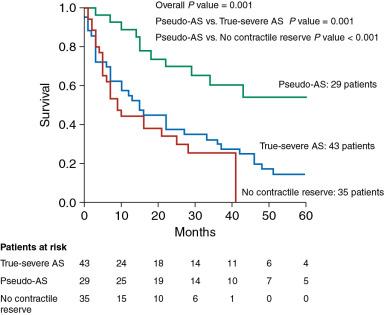
There is a close linear correlation (R = 0.81, P < 0.0001) between valve weight and AVC scores, as demonstrated in a study of 126 severe AS patients who underwent AVC scoring within 6 months of AVR. However, despite a mean AVA of 0.77 cm 2 and a mean gradient of 55 mmHg, AVC scores exhibited a very wide variation (59–11,000 AU). AVC scores do not follow a normal distribution in population studies, and progression of AVC has been associated only with male sex and baseline calcification. Males have consistently had more calcification and higher valve weights despite similar amounts of hemodynamic obstruction from AS. , Studies defining optimal AVC cutoff values are sex specific, with more than 1200 AU for women (>300 AU/cm 2 for AVC density) and more than 2000 for men (>500 AU/cm 2 for AVC density) for severe AS.
The utility of AVC in clinical decision making remains unclear. Some experts suggest using AVC scores in classic low-flow AS (stage D2) when there is a lack of flow reserve or for stage D3 disease. , However, AVC cutoffs were validated for severe AS by echocardiography during normal flow conditions (stage D1), and different treatment strategies have not been studied with the use of AVC scores. The prognostic value of severe AVC density is clear, with a 2.5-fold increased risk of mortality independent of clinical and hemodynamic parameters. Increased cardiovascular risk associated with AVC also has been well established in patients without valvular obstruction. ,
Become a Clinical Tree membership for Full access and enjoy Unlimited articles
If you are a member. Log in here